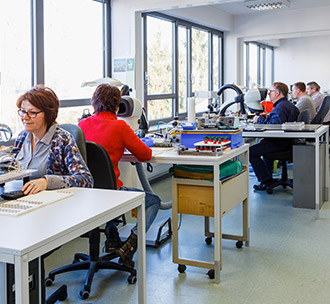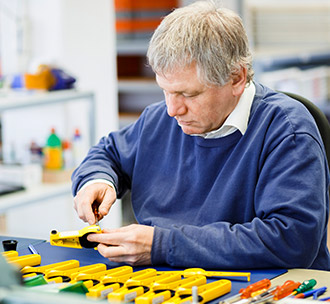1947 Europe and Germany struggle to recover from the war. Raw materials and resources are scarce and the slow reconstruction of West Germany can only take place with the support of the Allied Powers.
The engineer Nix and the physicist Erich Steingroever obtain a “provisional production permit” from the British military authorities. The first magnetic measurement and test devices, and the electrostatic voltage detector are produced.
1952 The division between West and East Germany becomes wider. Whilst the construction of socialism begins in the East, the West, with Allied support, was heading towards its “economic miracle”.
Upon the request of a Cologne lacquer factory, ElektroPhysik develops and manufactures the coating thickness measurement gauge MikroTest. In the previous year, a patent for the model had been applied for. The measuring device known worldwide as the Banana gauge is still used today.
1963 Thanks to the economic miracle, Germany becomes hardly recognisable. Luxuries such as televisions, cars and tourism transform the country. There are also considerable changes on the political stage. John F. Kennedy makes his famous “Ich bin ein Berliner” speech whilst Martin Luther King utters the legendary words “I Have a Dream”. The young Federal Republic of Germany gets Ludwig Erhard as its second Chancellor In the meantime, ElektroPhysik has begun to specialise on coating thickness measurement. The technologies for preservative surface finishing with lacquers, synthetic materials and enamel continue to develop. Soon enough, ElektroPhysik supplies its 100,000th MikroTest gauge
1979 The Cold War spurs a genuine innovation boom. New technologies develop, especially in the areas of electronics and communications. After the shock of the oil crisis, people become aware of the need to use resources sparingly.
The trend for refining preservative surface finishing continues unabated, with positive effects for ElektroPhysik too. The expansion of its sales and distribution activities in western Europe and overseas is a great success. ElektroPhysik opens its own site in the USA, as it had two years previously in Great Britain
1986 The Chernobyl disaster shocks the world. The nuclear catastrophe provokes protests against nuclear energy across the world. At the same time, ElektroPhysik successfully expands its product range to include microprocessor-controlled MiniTest devices.
1997 Global interconnectedness is no longer a mere vision of the future, but reality. Thanks to digitalisation, new paths open up towards complex testing and documentation systems.
ElektroPhysik establishes itself as a leading global manufacturer of measurement and testing devices. Its programme encompasses the entire domain of quality assurance in surface technology, corrosion prevention and road engineering.
2000 The new millennium doesn’t bring about the end of the world, but does see some catastrophes. Terror attacks such as 9/11 mark the still-young century and the reality of climate change becomes drastically evident. Yet there are also several positive changes: the German military makes a giant step towards equality, the Catholic Church elects a German Pope and the USA the first African American president. Globalisation, not least thanks to mobile phone technology, can no longer be stopped. As a pioneer in the area of non-destructive coating thickness measurement, ElektroPhysik, in cooperation with universities and research institutions, has successfully advanced the development and global standardisation of coating thickness measurement. An in-house development team of engineers and technicians ensure that our products are not only high performing and of the highest quality, but also that they are focused around design and usability.
2007 2007 begins stormily. Hurricane “Kyrill” rampages through Germany, keeping the topic of climate change firmly on the table. At the same time, the baby polar bear Knut conquers hearts everywhere, not only those of visitors to the Berlin Zoo. The year continues as tumultuously as it had begun, as a housing crisis that began in the USA goes on to have consequences that shakes the financial world.
ElektroPhysik is the first manufacturer of coating thickness measurement gauges to introduce digital sensor technology: sensor-integrated digital signal processing. SIDSP® = Sensor-integrated digital signal processing and has been trademarked by us. To this day ElektroPhysik is the only provider of digital sensors for coating thickness measurement.
2009 American makes history by swearing in its first African American president. Talking of history: the historic Cologne City Archives collapses during the expansion of the underground train network, burying valuable documents beneath its ruins. ElektroPhysik lives up to its reputation as a pioneer and trendsetter in non-destructive coating thickness measurement: One of the first ultrasound coating thickness measurement devices for measuring coating thickness on non-metallic substrates comes on the market: QuintSonic.
2013 At the beginning of the year the German Pope Benedict XVI announces his retirement to general surprise and the Argentine Pope Francis becomes the new head of the Roman Catholic Church. Just as surprising were Edward Snowden’s revelations that appear in the “Guardian” newspaper.
Just 4 years after the development of QuintSonic, ElektroPhysik revises the model and equips it with a digital sensor. With the QuintSonic 7 it’s now possible to measure up to five coatings in a single operation – effectively and with precision.
2015 As a result of the ever more precarious situation in several conflict areas, peaceful Europe is subject to a large-scale influx of refugees. Yet there are also positive news stories: conservative Ireland votes in a referendum for equal marriage and in the same year enshrines the decision in law. ElektroPhysik introduces the wireless sensor SmarTest. The intelligent wireless sensor relays all measurements with the help of Bluetooth via an app on mobile devices. In addition, SmarTest is compatible with all SIDSP® sensors, considerably enlarging its measurement portfolio


